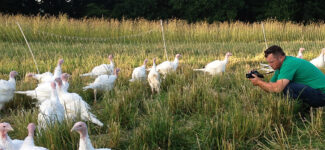No products in the cart.
Welcome to our website!
We're so happy you stopped by. Please let us know if you have any questions for us.

We're so happy you stopped by. Please let us know if you have any questions for us.
Don't forget to sign up for our mailing list to receive periodic emails about new products and upcoming events! You will also receive a Coupon Code for your first order.

The same as no antibiotics ever, this designation is fairly straightforward. Nevertheless, don’t be misled by “antibiotic free” – this just means the turkey may have received medication during its life, but underwent a withdrawal period to flush the drugs out of its system before harvest.
While free-range may paint pictures of a heavenly meadow, it typically means the birds live in fixed housing with outside runs, allowing them to stretch their wings and move around. To earn this stamp, producers only have to open the turkey pens to an open, common area for mere minutes a day. Only a few birds may take advantage of this, but all are then labeled free range. It can be a measure of quality, but it can also be deceptive, so caution is justified in this case.
Product that has been cooled below 26 degrees Fahrenheit, but not 0 degrees. So, it’s not labeled as frozen or fresh, but may say “not previously frozen.” When it comes to supreme quality and safety, “frozen” turkeys, which are flash frozen below zero right after being butchered, are actually much fresher than “fresh” turkeys, which can sit around for days before processing and transporting to the shelves, and eventually your dinner plate.
Heritage turkeys originate from old blood lines that haven’t been crossbred with more modern varieties, yet take two to four times longer to mature and are consequently quite a bit more expensive. When it comes to the heirloom tag, it’s a bit harder to nail down without an industry baseline, however it mainly refers to a heritage breed crossed with a modern broad breasted bronze, black or other similar type.
Grain-fed with no antibiotics and allowed to roam freely, these birds are raised under rabbinical supervision. This process includes soaking in a salt brine, which imparts a distinctly savory flavor profile. Similar to basted or self-basting turkeys, a solution is added to the meat to augment the weight.
This is a minimally processed product, devoid of supplemental coloring or artificial ingredients. Yet, this has nothing to do with how the turkey was raised, so antibiotic use and other factors may be unknown to the consumer.
Turkeys labeled as “organic” must be certified by a USDA-accredited certifying agency. A certified-organic turkey will have been raised on 100% organic feed, given access to the outdoors and will never have received antibiotics. However, there are no guarantees on anything else.
Pasture-raised is more ideal, in the sense that each turkey is grown out and finished in mobile housing that is frequently moved across a field. This supplies continuous fresh forage, cleaner surroundings and when done successfully, produces fertilizer that rejuvenates the farmland and creates the flavorful, nutritious product you see on the shelves. Occasionally, regenerative agriculturists take it a step further by implementing carbon sequestration techniques.
Non-GMO Project Verified turkeys are not fed genetically-modified crops, such as corn or soy; usually, alternative ingredients — fish meal, peas and other protein sources — are used as replacements.
We ourselves raise primarily hens for holiday birds because they have a nice distinctive shape at much smaller weights since hens more quickly build muscle as they grow. Toms spend their first few months building bone structure so they are quite a bit larger before they make a nice, shapely presentation with the beautiful breast meat that most folks are looking for.
Any turkey under 8 months old can be labeled “young”. Nowadays, anything that falls under the usual weight range for holiday birds is well under 8 months old by the time it is processed so technically it is all ‘young’ turkey. It can really be a hollow sales pitch.
The USDA does not approve hormone use in production of turkeys in the US.
You can read these helpful articles too:
https://www.pdxmonthly.com/sponsored/2019/11/know-thy-poultry
No products in the cart.
